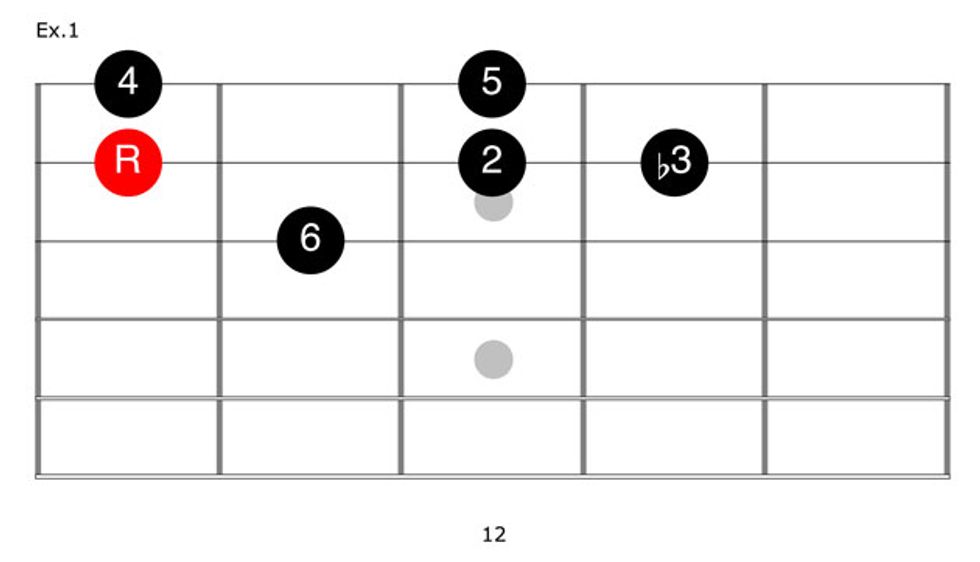Chops: Beginner
Theory: Intermediate
Lesson Overview:
• Create simple and meaningful blues phrases in the style of B.B. King.
• Understand how to emphasize chord tones over a blues progression.
• Learn how to use repetition to build tension in your solos.
Click here to download a MP3 and printable PDF of this lesson's notation.
Riley B. King (aka B.B. King) is known the world over as one of the greatest blues musicians in the history of the genre. His tone, attack, vibrato, phrasing, stage presence, and human spirit offer plenty to emulate and learn from, but there’s an ace of a scale hiding up Mr. King’s sleeve, and this lesson will reveal this barely discussed, yet very useful concept. This scale is especially valuable if you’re a blues, rock, jazz, funk, or country guitarist looking to discover a new world of licks.
The first thing you should know about the “B.B. box” shown in Ex. 1 is that it fits uniquely over dominant 7 chords and progressions, but use it with caution over chords in minor blues tunes. This scale produces an interesting flavor you’ll hear not only in King’s music but also in the licks and riffs of Jimmy Page, Stevie Ray Vaughan, Billy Gibbons, and Eric Clapton, among others. In modal terms and typical blues-rock situations, a dominant 7 chord progression begs for a Mixolydian-based scale treatment. As you will see, things are a bit different when using King’s scale.
Now that you’ve learned the scale’s basic fingering, you should notice how good it sounds by simply playing it ascending and descending over an A7 chord (Ex. 2). Be sure to add some smooth vibrato on that final note.
Click here for Ex. 2
As you can see and hear, this scale is very user-friendly. Once you’ve become acquainted with this scale, you’ll eventually find your fingers reaching for licks, patterns, and phrases that you’ve never played before—and you may wonder what you ever did without it. Use the first note on the 2nd string as a guide to help you move this scale into other keys. Wherever you place this root note (shown in red in Ex. 1) dictates the key you’ll be playing in.
As you play through this example and get a feel for the fingering and sound, be aware that we’re technically flirting with an A Dorian tonality over an A7 chord. For those of you playing along at home, that’s technically a big no-no in traditional music theory terms, but in the rebellious world of blues and rock music, a skilled soloist can make those “wrong” notes sound legendary. It is interesting that this scale really sings against dominant 7 chords and progressions, but it sounds a little sour against a standard minor blues.
After all, this is technically a minor-sounding scale (with an obvious b3) and it features a distinctively Dorian sound. So why does this scale not really work over a minor blues?
One reason this scale works better over dominant chords is the appearance of the natural 6 (in this case, F#). It works fine over an Am7 chord but when the IVm chord (Dm) rolls around, the rub between the F# and F is a bit jarring. In a dominant-sounding situation the IV chord contains an F#—much better.
Whenever you’re playing over dominant-flavored blues changes, you’ll find that this scale is very handy to have in your bag of tricks, and it’s a great “cut-and-paste” option. The scale is especially useful when improvising an extended guitar solo and you suddenly run out of ideas.
To expand this scale even further, you can add the B.B. King-approved chromatic note b5 on the 1st string. This creates a jazzy flavor and really adds a touch of class when used tastefully and targeted wisely (Ex. 3).
Click here for Ex. 3
Now that you have a grip on playing this scale, try learning some licks to really get an idea of where this scale can take you. To get the ball rolling, play around with these three licks in Ex. 4, Ex. 5, and Ex. 6.
Click here for Ex. 4
Click here for Ex. 5
Click here for Ex. 6
The next step of really expanding the application of this scale would be to navigate through a blues progression and target the specific notes relative to each chord as they appear. Start by locating and understanding the function of each note over the IV and V chords.
As you’ll find, each of the three root notes from the chord progression (A–D–E) are present within this scale, which makes it easy to use over the entire 12-bar blues progression. Play through Ex. 7, Ex. 8, and Ex. 9 to get a feel for how to zero in on specific chord tones.
Click here for Ex. 7
Click here for Ex. 8
Click here for Ex. 9
Finally, here's a backing track in the key of A to help work out some of these ideas.
As you continue to play with this scale, incorporate more pentatonic ideas. Pretty soon you’ll be connecting licks all over the neck. Heck, if B.B. has been using these ideas since 1937, it should take you a good long while to wear them out. If it’s good enough for Mr. King, it’s good enough for all of us.


























